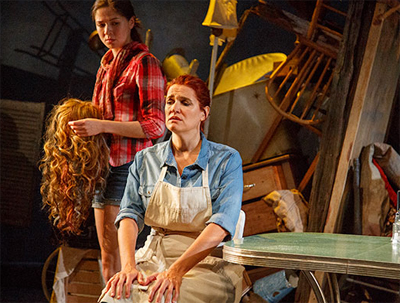
Greek mythology meets a small Quebecois fishing village in The Flood Thereafter playing at Toronto’s Berkeley Theatre
I’d never really thought about Greek mythology in the context of a small Quebecois fishing village, but Sarah Berthiaume’s The Flood Thereafter is an interesting re-imagining of the travels of Odysseus, brought to vivid corporeality at Canadian Stage’s Berkeley Theatre.
The Flood Thereafter hones in on the specific involvement of the sirens in the Odyssey, gorgeous sea creatures who enticed sailors into the depths with their song. The sirens in Berthiaume’s story are Grace and her daughter June, both seemingly tied to the village and its men, unable to move on. Grace owns a diner, and June has taken to stripping to earn her living, her nude form so potently beautiful that it makes the men cry. It’s the arrival of a stranger, a young man named Denis, who starts to shake things up.
Nadine Desrochers’s translation – Berthiaume’s original text is in French – is elegant and clear. The longer speeches and dramatic moments carried the same expressive weight as they would have in their original form. What I found a little off, however, were the moments of humour. I felt that some of the lines in the lighter scenes of the show were missing something and I wonder what they would’ve sounded like in French. This could be just me though, being born and raised in Montreal and no stranger to the language. My date for the evening, an anglo Ontarian, didn’t notice anything off-putting.
I thought the actors fit their roles well and performed admirably, but I’m not sure I can say if any of them particularly wowed me. I found the pace of the show to be especially languid, which worked well at the beginning, easing me into its mythical realm, but not so much in the latter third after the play’s pivotal scene between Denis and June. In all its gorgeous ethereality, I still felt like the production was missing some grounding, something more to anchor the audience before letting us float away into Berthiaume’s world.
What impressed me most about this production was Yannik Larivee’s set design. The stage is set up to represent three different interiors in the town: the divey strip bar where June works, June’s home and mother’s diner, and the home of Penelope and Homere. It’s an open concept that offers a seamless flow from one scene to the next, echoing the fluidity of the river that’s such a prominent theme in the show. The details of the set are especially breathtaking, with a back wall and archway made up of piles of shipwrecked furniture, the kind of flotsam and jetsam you’d find washed ashore from who-knows-where, and an old fishing boat hanging high above in the flies.
My favourite part of it all was the swinging saloon door that opened from backstage into the strip club. It’s attached to the husk of a piano, strings intact, so that if you listen closely whenever the actors slam it shut, you can hear it ring for a brief moment. This paired with the live sound effects, conceived by John Gzowski and provided by the actors as they wandered backstage, truly brought the mystical world of the play to life.
It’s an interesting take on an old story that can be captivating, but isn’t quite for everyone.
Details
-
The Flood Thereafter is playing until October 6th at Canadian Stage’s Berkeley Street Theatre, 26 Berkeley Street
-
Shows run Tuesday-Saturday at 8 pm, Wednesday at 1:30 pm, Saturday and Sunday at 2:00 pm
-
Tickets range from $22-$49
-
Tickets can be purchased online
Photo of Courtney Ch’ng Lancaster and Patricia Marceau by Bruce Zinger.
